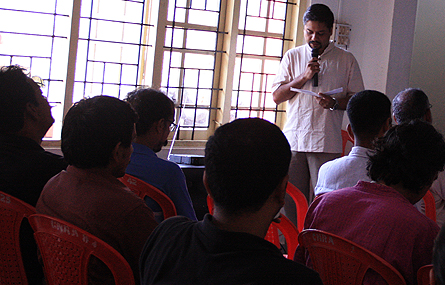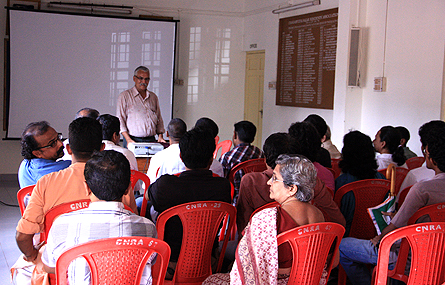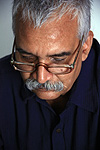Event: Prof Kirti Trivedi Lecture (June 19, 2011)
"SUSTAINABLE RICH LIFE FOR ALL"


Yeldtho T Mathew, Swarajist and one of the Founding Members of Friends of Tibet Foundation for the Wellbeing, reports on a lecture by Prof Kirti K Trivedi of IIT Bombay on "Sustainable Rich Life For All" — organised by Design & People on June 19, 2011 at Kochi. (Photos: Prince Prabhakaran)
Kochi, Kerala: A talk was arranged by Design and People for select audience. All except a few like me were from the field of Design. I got the opportunity to be among the experts by a curious design by my friend Sethu Das, Co-founder of Design & People who thought me worthy of being in the crème audience. It evolved that the talk was more about Right Living where the design concepts can and should play a pivotal role. This report is not a verbatim reproduction of the talk, but is the inspired derivative of the talk.
Objects Rooted in Soil: Objects of Value.
It is a simple sounding but profound statement. We are surrounded by objects of desire which necessarily may not be rooted in soil and we are bombarded by advertisements driving us to chase and own them. According to Prof Trivedi, this is sharply in contradiction to the sustainability in its real meaning.
The way of life as we have now is not sustainable, even for the rich. The simple statistics that against a population increase by 50% over the past 50 years, the corresponding resource utilisation has increased by 1000% means that we are eating up all that is there at such speed that there won't be much left for the coming generations.
There have been experiments in certain countries like Singapore for sustainable economy. The conclusion was to encourage and promote more and more consumerism. This means, the sustainability they were worried about was from the view point of the manufacturers and the rich, not about the overall sustainability of the mankind, the resources, the earth, etc. Hence such experiments have no relevance to the subject matter.
There is a notion that the material goods consumption is a driver of economy. So it is necessary to encourage the consumption. The growth and development of a country is gauged by its goods consumption. The terms GDP, PPP (Purchase Power Parity), etc used to assess how developed a nation is, are not realistic ones. A major portion of the consumption of goods is by a miniscule section of society because wealth is concentrated in this small section and thus arriving at a per capita figure with this kind of data would be totally misleading, especially in a country like India where the per capita earning is said to be hardly Rs 20 per day. As Gandhiji taught and as Dr APJ Abdul Kalam commented, so long as the benefits of the so-called development do not reach the ordinary citizen living in the remotest villages, such development has no real worth.
India used to follow a tradition and economy based on preservation, conservation and mutual support, different from the later shift towards the one based on consumerism, wealth accumulation and selfishness, a change fueled by the industrial revolution.
The life cycle of a product (of the resource used for it) is getting shorter and shorter. Earlier one radio or a cycle or any other useful possession used to serve one generation and was then passed on to the next and so on, meanwhile undergoing repairs and maintenances until at last they can no longer serve the purpose. In resource utilisation of yonder time there really was no 'cycle' but an ever progressing straight line. Buy → Use → Repair → Use → Repair → Use → ... → Recycle Unusable Parts → Use the remaining parts for other use → so and on and on until over a long time it disintegrates into the five elements. Now there is a clearly defined cycle: Buy → Use → Throw Away → Buy. Alarmingly the cycle is getting shorter and shorter. Estimate is that the resource taken from earth becomes waste in just three months!
This trend can be traced back to Industrial Revolution. The face marks of the subsequent economy were:
- Mass production concept came into being;
- Colonisation by force, of non-industrialised nations began;
- Exploitation of the natural resources to create wealth for themselves became large scale;
- Self-sustaining cultural patterns and economies were subdued and a consumption dependent economy was introduced instead.
- Selfishness and personal greed started getting acceptability as a new desirable value for the society.
Role of Design Profession
The new economy depended solely on the consumption of the goods and therefore, it was part of this economy to get the society adopt selfishness and personal greed as desirable values. For this to happen, the Design profession has a lot of contribution to their credit and are still treading this path.
The objective of the current day advertisements is to create desire. The design professionals achieve this through:
- Branding.
- Constant creation of new models.
- Rapid cycle of perceived obsoleteness.
- Keeping people dissatisfied over what they have and creating temptation.
Prof Trivedi explained all these, citing one small but powerful advertisement of iPhone (Finally! iPhone4 is now in white!). It will appear as though the main reason for all the miseries and chaos in the world was because iPhone was not in white. And anyone who buys it will gain, now that it is available in the market.
There are advertisements which drive us to buy certain TV not to watch it, but to generate envy in your neighbour. Soft drinks advertisements teach us that girls will flock around you, if only you drink these soft drinks! Thus the design profession has a lot to do with the current order of things.
Material/Physical Economy
One of the traits of material/physical economy is that the material wealth reduces by sharing. Exclusivity has more value under this economy which means rare possession is more valued. More effort is required to accumulate more material wealth and a lot more effort to protect it. The material economy gives certain undesirable byproducts as well. An accumulative instinct is developed gradually among the populace. There is a race and competition in owning more and more. A stress of ownership is developed. Above all, selfishness becomes an inseparable element in one's character. The end result is that just 200 years of following this kind of economy has made life unsustainable. Fortunately, material economy is about to end and the world is entering into knowledge economy which has completely opposite set of properties.
Knowledge & Creative Economy
The knowledge economy expands and grows when shared. Under this economy, one time effort continues to create wealth. The products under this economy are more valuable if more people use them. It promotes sharing, collaborating, creating, etc. Apart from the physical and material wealth, many different kinds of wealth emerge. This economy has a visible form now in the emerging digital life style. In digital world, there is a disappearance of the physical and there is multiple use of the same physicality. Physical owning has got less significance and there is more value in sharing and collaborating. New parameters of wealth are getting defined.
Traditional Asian Way of Life
When we talk about different economies, it is apt to examine our traditional ways. Our traditional life style was far less stressful than today. Life was given full attention and each moment was spent wakefully. To be short, unlike the present day mechanical life and mere surviving, we were living.
Life was in a sitting down posture. If we go back to few hundred years or even less, we had the tradition of being in touch with the earth; of walking bare footed, of sitting down on the floor, of wearing clothes that are attuned to the nature and climate.
There were no chairs and all were squatting on the floor which gave a semblance of equality. There were not many furniture at home, multiplying the usability of space. Intellect and creativity were accorded highest priority. Thousands of years ago, clad in tattered robes, our Rishis (seers) could dwell in the highest realm of intellect and creativity. Many sciences reached glorious levels during this time. Great souls like Charaka, Susruta, Vagbhata, Agatsya and other performed their Karma based on the tradition they practiced.
The Tea Ceremony in Japan has less to do with the act of preparing and drinking tea (though these are performed in a ceremonial manner) than about contemplation and intellectual discussions. This again reflects the traditional Asian way of life. But upon our blind adoption of all that is western, we lost many things, including our self-sustained economy. A Promising economy 'Sarvodaya — welfare of all' — Go back to the villages
There is enough to meet everyone's need but enough to meet even a single person's greed, Gandhiji said. Gandhiji always had an answer to any question, simple or complex. He had an alternative to the self-destructing, unsustainable, consumption-based economy. He postulated the same and called it 'Sarvodaya — the welfare of all'. The world is waking up to the realisation that probably his economic principles would be an answer to the challenges faced by the other economies. He evolved his principles from the ancient village republics of India. Each village, while being self-sustaining, was also to support its neighbor. None was expected to consume or own beyond one's need. Each article produced was to be used to its last. The story about Gandhiji searching of a 3 centimeter long pencil, while he should have been busy with the freedom struggle is a glimpse to show how much importance he accorded to maximising the utilisation of resources which translates as minimal exploitation of the same.
Prof Trivedi was referring to this maximisation when he was talking about restrictive designs in constructing a house. It was not our tradition to construct different spaces for different purposes. Now we have a drawing room, a dining room, an office, few bed rooms, etc. Now there is even an acclimatising room before entering the drawing room! This is amounting to limiting the usability of space which, without the paraphernalia and furniture associated with the such designated rooms, could have been transformed to suit many purposes. This is maximisation of resource. Instead of having drawing rooms, dining rooms, halls, bed rooms, etc, the same space could serve all their purposes. But one sofa, few chairs, one table, lo, the usability has reduced from inifinity to one. Our ancient builders were experts in space optimisation.
They had the supreme knowledge that the more one identifies with small things the more she/he diminishes herself/himself.
As to the consumerism, Gandhiji says that intelligent curbing of one's wants is the key to freedom. Instead of each time buying a new piece, he insisted on mending the old one. Unfortunately today, as HD Thoreau remarked, it is not a mark of a respectable person to move around in patched clothes. The very society accepts a person in 'respectable' clothes even if his conscience is tattered.
India is in its villages. We need to go back. We need to revisit our traditions. Sustainable economy was a treasure we gave up once. We need to claim it and own it and guard it. We need to re-learn the sitting-posture-culture. We need to root ourselves on earth.
Because, Objects rooted in soil — objects of value!
 Prof Kirti Trivedi is an internationally renowned design educator, designer and thinker. As a professor at the Industrial Design Centre (IDC) at IIT Bombay (1975-2014), he initiated and founded India's first Master of Design Programme in Visual Communication. After a degree in Mechanical Engineering, he did postgraduate studies in Industrial Design from IIT Bombay and the Royal College of Art, London. In 1981, he worked as a UNESCO Fellow in Japan, under the guidance of Prof Kohei Sugiura. He also helped set up the Centre for Asian Art & Design at the School of Art, Design and Media at NTU in Singapore, when working as a Visiting Professor there in 2011.
Prof Kirti Trivedi is an internationally renowned design educator, designer and thinker. As a professor at the Industrial Design Centre (IDC) at IIT Bombay (1975-2014), he initiated and founded India's first Master of Design Programme in Visual Communication. After a degree in Mechanical Engineering, he did postgraduate studies in Industrial Design from IIT Bombay and the Royal College of Art, London. In 1981, he worked as a UNESCO Fellow in Japan, under the guidance of Prof Kohei Sugiura. He also helped set up the Centre for Asian Art & Design at the School of Art, Design and Media at NTU in Singapore, when working as a Visiting Professor there in 2011.
Besides teaching and design research, he is active as a design consultant in the areas of product design, design management and product planning, graphic design, book design, exhibition and museum design, environmental graphics and signage design, with numerous awards and publications both nationally and internationally. He was among the 100 leading typographers from around the world invited to participate and present their work in Typojanchi, first International Biennale of Typography in Seoul, South Korea; and bt'09: the Beijing Typography exhibition in 2009. He is frequently invited to present papers at international design conferences; and was an invited expert at the Asian Round Table Conference on 'Asian Design', organised by the Asia Club, Tokyo. He helped draft the ICOGRADA Design Education Manifesto 2000, as part of the International working group to prepare a manifesto for the future of design education.
His major projects include a permanent exhibition on MahatmaGandhi: 'My Life is My Message' at Sabarmati Ashram, Ahmedabad; 'Vinoba Darshan' at Gopuri, Wardha; and the National Salt Satyagraha Memorial at Dandi, for which he is the Head of the International Design Team. 'K-Yan' — an integrated community computer developed by him is now widely used in classrooms in India.
His current research is in developing appropriate interaction design solutions for Indian needs based on emerging technology possibilities; universal and self-evident design; and in defining rich learning environments to replace institutionalised teaching. He is the founder-director of ADARG (Asian Design and Art Research Group); and is engaged in several book projects related to Indian Letterforms, Iconography and Asian Design Philosophies.
⋯
Design & People Foundation, PO Box 16674, Mumbai 400050
Digital Support: Ibiblio Digital Library & Archive Project, University of North Carolina, USA
